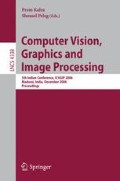Abstract
Video has become an interactive medium of daily use today. However, the sheer volume of the data makes it extremely difficult to browse and find required information. Organizing the video and locating required information effectively and efficiently presents a great challenge to the video retrieval community. This demands a tool which would break down the video into smaller and manageable units called shots.
Traditional shot detection methods use pixel difference, histograms, or temporal slice analysis to detect hard-cuts and gradual transitions. However, systems need to be robust to sequences that contain dramatic illumination changes, shaky camera effects, and special effects such as fire, explosion, and synthetic screen split manipulations. Traditional systems produce false positives for these cases; i.e., they claim a shot break when there is none.
We propose a shot detection system which reduces false positives even if all the above effects are cumulatively present in one sequence. Similarities between successive frames are computed by finding the correlation and is further analyzed using a wavelet transformation. A final filtering step is to use a trained Support Vector Machine (SVM). As a result, we achieve better accuracy (while retaining speed) in detecting shot-breaks when compared with other techniques.
Access this chapter
Tax calculation will be finalised at checkout
Purchases are for personal use only
Preview
Unable to display preview. Download preview PDF.
References
Zhang, H., Kankanhalli, A., Smoliar, S.: Automatic partitioning of full-motion video. ACM Multimedia Systems 1, 10–28 (1993)
Bang, C., Chenl, S.C., Shyu, M.L.: Pixso: a system for video shot detection. In: Fourth International Conference on Information, Communications and Signal Processing, pp. 1320–1324 (2003)
Shahraray, S.: Scene change detection and content-based sampling of video sequence. In: SPIE Storage and Retrieval for Image and Video Databases, pp. 2–13 (1995)
Swanberg, D., Shu, C., Jain, R.: Knowledge guided parsing in video database. In: SPIE Storage and Retrieval for Image and Video Databases, pp. 13–24 (1993)
Funt, B., Finlayson, G.: Color constant color indexing. Pattern Analysis and Machine Intelligence, IEEE 17, 522–529 (1995)
Rasheed, Z., Shah, M.: Scene detection in Hollywood movies and TV shows. In: IEEE Conference on Computer Vision and Pattern Recognition, pp. 343–348 (2003)
Patel, N., Sethi, I.: Video shot detection and characterization for video databases. Pattern Recognition 30, 583–592 (1997)
Li, D., Lu, H.: Avoiding false alarms due to illumination variation in shot detection. In: IEEE Workshop on Signal Processing Systems, pp. 828–836 (2000)
Lu, H., Tan, Y.: An effective post-refinement method for shot boundary detection. CirSysVideo 15, 1407–1421 (2005)
Zabih, R., Miller, J., Mai, K.: Feature-based algorithms for detecting and classifying scene breaks. Technical report, Cornell University (1995)
Yuliang, G., De, X.: A solution to illumination variation problem in shot detection. In: TENCON 2004. IEEE Region 10 Conference, pp. 81–84 (2004)
Ngo, C., Pong, T., Chin, R.: Detection of gradual transitions through temporal slice analysis. In: IEEE Conference on Computer Vision and Pattern Recognition, pp. 36–41 (1999)
Yeo, C., Zhu, Y.W., Sun, Q., Chang, S.F.: A framework for sub-window shot detection. In: MMM 2005: Eleventh International Multimedia Modelling Conference (MMM 2005), pp. 84–91 (2005)
Amir, A., et al.: IBM Research TRECVID-2005 Video Retrieval System. In: TREC Proc. (2005)
Vlachos, T.: Cut detection in video sequences using phase correlation. Signal Processing Letters 7, 173–175 (2000)
Yoo, H.W., Ryoo, H.J., Jang, D.S.: Gradual shot boundary detection using localized edge blocks. Multimedia Tools and Applications 28, 283–300 (2006)
Petersohn, C.: Fraunhofer HHI at TRECVID 2004: Shot boundary detection system. In: TREC Proc. (2004)
Covell, M., Ahmad, S.: Analysis by synthesis dissolve detection. In: International Conference on Image Processing, pp. 425–428 (2002)
Lienhart, R., Zaccarin, A.: A system for reliable dissolve detection in videos. In: International Conference on Image Processing, pp. 406–409 (2001)
NIST: TREC Video Retrieval Evaluation (2005), http://www-nlpir.nist.gov/projects/trecvid
Author information
Authors and Affiliations
Editor information
Editors and Affiliations
Rights and permissions
Copyright information
© 2006 Springer-Verlag Berlin Heidelberg
About this paper
Cite this paper
Manickam, N., Parnami, A., Chandran, S. (2006). Reducing False Positives in Video Shot Detection Using Learning Techniques. In: Kalra, P.K., Peleg, S. (eds) Computer Vision, Graphics and Image Processing. Lecture Notes in Computer Science, vol 4338. Springer, Berlin, Heidelberg. https://doi.org/10.1007/11949619_38
Download citation
DOI: https://doi.org/10.1007/11949619_38
Publisher Name: Springer, Berlin, Heidelberg
Print ISBN: 978-3-540-68301-8
Online ISBN: 978-3-540-68302-5
eBook Packages: Computer ScienceComputer Science (R0)

